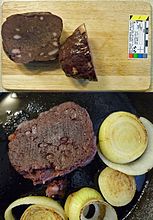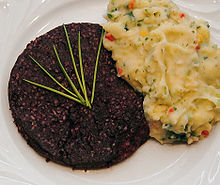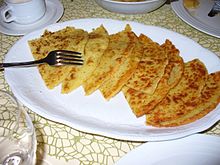
The traditional cuisine in Westphalia is characterized by simple and hearty dishes. The not exactly affluent population had to earn their living through hard physical labor. The miners and steelworkers often had an allotment garden in their houses. Home grown vegetables and fruits enriched the menu and were good for the families and the household budget. Those who also reared chickens, rabbits and pigeons also had a tasty meat meal every now and then. Everything that the harvest produced was used, mainly dishes with potatoes, cabbage and root vegetables. With eggs, milk, butter and flour, the dishes were enhanced in terms of calories. A tasty dish was created even from stale bread and rolls.
Westphalian specialties
- Westphalian bone ham, which is only salted by hand during production, comes exclusively from the administrative districts of Detmold, Münster and Arnsberg. It is a traditional raw ham from Westphalia with a particularly spicy aroma.
- Colorful Bentheim pig with floppy ears, black spots and a friendly nature.
- Westphalian Mettwurst consists of half pork and half bacon, some of which is only roughly chopped. It is a spreadable, coarse sausage that can also contain beef.
- The Mettenden belong to the classics of Westphalian cuisine and are smoked or air-dried sausages made from pork. They taste particularly good in carrot stew, pea stew.
- Westphalian Möppken bread is a specialty made from sausage broth, pork blood, rye meal and pumpernickel, where raisins make the special taste. Once a waste recovery from house slaughter.
- Panhas is a further version of the residual recycling in the case of home slaughtering from sausage broth, pig blood and pearl barley. A thick slice of Panhas is fried in lard in a pan and served with mashed potatoes and carrots.
- Liver bread made from sausage broth, pork blood, minced pork liver and diced fat bacon. It is coated with sugar beet and eaten cold.
- Dortmund salt cake are caraway rolls with ground meat and onions.

Möppkenbrot

fried panhas slice with vegetable mashed potatoes

Dortmund salt cake
- The (also that) pumpernickel is an originally Westphalian type of bread. It has been baked in Soest near Haverlandt since 1570, the oldest still existing pumpernickel bakery. The bread, originally made from rye meal and water, baked in a gentle process for 24 hours at a good 100 degrees, has a long shelf life and was previously used as a nutrient-rich food on long-distance trips.
- Pumpernickel soup is a typical regional bread soup of the Westphalian cuisine, which is mainly made from pumpernickel
- You also make that from pumpernickel Pumpernickel pudding, the Westphalian counterpart to Mecklenburg black bread pudding.
- Stromberger plum, around Stromberg in Oelde, thousands of plum trees lined up in plantations. The small town in the Westphalian bay has been a center of plum cultivation for 200 years and has since been known for its aromatic fruits.
- Nieheim cheese
Seasonal dishes
- Kale with sausage and smoked bacon.
- Cream baked apple for the cold season.
Soups
- Barley stew with salted meat (pork knuckle or ribs).
- Westphalian barley soup (Creme d'orge à la westphalienne). (Barley soup) For this barley gruel soup, barley is boiled in ham broth. Then the soup is bound with cream. Cooked cubes of ham, carrots, celery and potatoes are added before serving.
- cabbage soup Sauerkraut, potatoes and pork.
- beer soup sweet with sugar, eggs, milk and beer.
- Thick milk soup (Danish milk soup), curdled milk with cream, egg yolk, pumpernickel and currants.
- Pea soup Form small dumplings from freshly peeled (freshly peeled) peas with lump (from flour, milk, butter, eggs) and slide them into the hot soup.
- Pea soup Prepared from dried peas with hearty pork knuckle and Mettwurst is one of the main Westphalian dishes.
- pumpkin cream soup with chicken broth and chicken.
- Carrot stew with fresh bratwurst or sausage.
- spring soup across the garden, all types of vegetables that are in season are suitable.
- Blind chicken, white, green beans, carrots, potatoes, apples, pears, twins and mixed bacon.
- Westphalian potato soup cooked with floury potatoes, some white cabbage, a few carrots, a piece of celery and meat broth.
- Apple soup with raisins.

Blind chicken with meatloaf and pork bacon

Carrot soup with sausage

Krustchen - Schnitzel toast with fried egg
meat and vegetables
- Pfefferpotthast (Piäpperpottharst) is a Westphalian, goulash-like stew (beef) that is prepared in a pot (pot). There are boiled potatoes and pickles.
- Wrong chop; fresh streaky bacon is breaded and fried in the pan and served with Brussels sprouts and boiled potatoes.
- Sauerbraten with potato dumplings and fresh applesauce.
- Munsterländer Töttchen (Veal head ragout), served with fresh rolls and a cold beer.
- Westphalian crust Schnitzel toast with fried egg.
- Westphalian Schlabberkappes is a white cabbage dish with beef (high rib), also called smeared cabbage.
- Meatloaf, seared roast, minced roast, false rabbit or hypocritical rabbit is a roast made from minced meat, which is known in various forms in many countries.

Schlabberkappes
.jpg/220px-Hackbraten_Leicht_Kemmern_(1).jpg)
Meatloaf (false rabbit) with dumplings and sauce
- Sour leg of mutton with Gribiche sauce with boiled potatoes.
- Cut beans in bacon sauce with boiled potatoes.
- Broad beans with smoked pork belly.
- cabbage rolls White cabbage leaves filled with mixed minced meat with boiled potatoes and sauce.
- Cured pork knuckle with surmoos (Sauerkraut) the pork knuckle is served on the cooked sauerkraut with mashed potatoes and mustard.
- Roast rabbit with dumplings and red cabbage.
- Braised pigeons served with fried potatoes.
- Turnip stalk, also as Stick jam called, cooked with beef broth and potatoes, as soup or puree.
Pastries
- Shortbread biscuits
- Eiserkuchen (ice cream cone)
Sweets
- Lippischer Pickert is a former poor people's meal and is now a specialty of the Lipperland. It differs from the Westphalian variant in the way it is prepared: It is baked on a cast-iron pickert plate. There are several types and shapes of Pickert.
- French toast a simple dessert that children especially like. Turn white bread slices in egg milk and fry them in a pan in hot clarified butter until golden brown on both sides, sprinkle with cinnamon and sugar and serve immediately.
- Blind fish is a regional name from the Münsterland for a simple dish made from baked rusks, milk and sugar. She is also known under the name "Poor Knight". You can alternatively use stale rolls or toasted bread for the preparation. A vanilla sauce refines this dessert.
- Struwen. are yeast pancakes that are traditionally eaten on Good Friday.
- Masurian Glumse Quark dish with cream and raisins.
- Rhubarb compote served with liquid cream.
- Westphalian jelly made from pumpernickel (black bread) with cherry compote and whipped cream (or quark cream) - has nothing to do with jelly-like jelly.
.jpg/220px-Lippischer_Pickert_(coreforce).jpg)
Lippischer Pickert

Westphalian Pickert

Struwen

Westphalian jelly
from Omma
- Westphalian snack with lard, coarse liver sausage, raw ham, black pudding, aspic, meat sausage, meatballs
- Roasted liver sausage on pumpernickel
- Fried green herrings with potato salad or jacket potatoes.
- Eggs in mustard sauce Homemade mustard sauce is a real all-rounder and a highlight with eggs, potatoes, meat or fish! A classic roux (butter, flour and meat or vegetable broth) prepared, refined and properly rounded off with mustard.
- bacon pancakes In the Münsterland, the flat cakes made from flour, eggs and milk also like to be served heartily with crispy bacon.
- Sausage rolls made from yeast dough and fine sausage.
- potato waffles
- Jacket potatoes with quark tip Jacket potatoes with bacon onions and pork.
- Reibekuchen Sprinkle with sugar or serve with applesauce.
beverages
Wine
beer
- As is the case in other regions of Germany Pilsner the most popular type of beer in Westphalia. Some of the mass beers sold nationwide come from Westphalia: Krombacher Pils, Veltins Pils, Warsteiner Pilsener. There are also various regional and local Westphalian pilsner brands
- Altbier, a dark, top-fermented type of beer based on the old, traditional brewing method, is not only produced on Lower Rhine and around Dusseldorf, but also brewed in Westphalia: Barre Alt, Alt from Dahl, Freilraf Alt, Hansa Alt, Paderborner Alt, Pinkus Original Alt, Rolinck Westfälisch Alt, Überwasser-Alt. Today manufactured in Westphalia, but of genuine Rhenish origin are: Frankenheim Alt, Rhenania Alt, Schlösser Alt.
- Altbierbowle is mainly offered in Münster; the most popular is the variant with strawberries.
- export a typical Dortmund beer has a strong golden yellow color, a strong, malty taste and a slight sweetness. Some varieties: DAB Dortmunder Aktien Bier, Dortmunder Bergmann Export, Dortmunder Hansa Export, Dortmunder Kronen Export, Dortmunder Stifts Bier, Dortmunder Union Export, Ritter Bier and Moritz Fiege Export as well as Paderborner Export. There are other varieties locally that are not so well known.
Booze
- Münsterländer Korn: The taste of the grain fields in a pin. Grain has been distilled in the Münsterland since the 17th century and is known far beyond for its spicy but soft taste, because aromas or colorings must not be added.
- Steinhäger juniper
- Steinhäger Korn
- Sendenhorster grain
- Böcker Korn
- Ehringhausen spelled grain
- Lager grain from the Sasse distillery
Liqueurs and toppings
- Black currants
- Blackberries
- Sloes
- Cherry
- Advocaat
- Chain fat liquorice liqueur
Herbal liqueurs
- Kreutzkamp`s Cappenberger droplets is a herbal liqueur with an alcohol content of 38% vol.
- Liqueur specialty Dortmund drops is a composition of fruit peel distillates, herbal extracts and Jamaica rum.
- August with the tie, tasty herbal liqueur made from seeds, roots and medicinal herbs, is made according to a 150-year-old recipe.
coffee
Schirmer Kaffee the traditional Dortmund brand of freshly roasted quality coffees.
Soft drinks
- Ardey Quelle, a long-established Dortmund mineral spring bottler with lemonades and spritzers in the eastern Ruhr area and South Westphalia.
- Brohler mineral and healing fountain, Steinsiek / Löhne
- Forstetal source, Horn-Bad Meinberg
- State Bad Meinberger Mineralbrunnen, Horn-Bad Meinberg
- Bad Driburg Nature Park Sources
- Teutoburg mineral fountain, Bielefeld
- Volkmarser Mineralbrunnen Waldhoff, Höxter
- Herzog Mineralbrunnen Schäfer, Bochum
Culinary calendar
Culinary delights are often seasonal. Fruits and vegetables are tastier when they are ripe; meat and fish are also subject to seasonal influences. Every season of the year, festivals are celebrated that have a general theme or focus on certain foods. There are also drinking and eating habits throughout the year that arose from religious traditions such as fasting times.
January
- Kale
- Brussels sprouts
Of course, we don't grow too much in January, which is why we have more stock items such as apples, parsnips, carrots and potatoes.
February
- Kale
- Brussels sprouts
March
- Parsnips, leeks, Brussels sprouts, spinach and the wild garlic season begins.
- Kale, newly cut shoots from the stalks of green and Brussels sprouts that have remained standing
April
- Turnip greens, also known as stem butter, are in season in spring between April and the end of May.
- Good Friday Struwen
- The Asparagus season begins, depending on the soil temperature, with asparagus spears from heated fields at the beginning of April
- Traditionally on April 23rd the Day of the beer celebrated, because on this day in 1516 the German purity law was proclaimed. There are events on the topic of beer in many places (German Brewers Association).
- End of April: end of the traditional Mussel season (Note: every month with "r")
May
- Rhubarb season
- Asparagus season. Now the asparagus comes from film tunnels and from the field. Farmer's wisdom: "Don't forget until Midsummer: Eat asparagus for seven weeks!"
June
- High season for local people Strawberries. Now they are not only red, but also ripe, sweet and juicy.
- On Midsummer Day, June 24th ("Asparagus New Year"), the season ends for asparagus and rhubarb. Perennial plants need time to recover, and the potentially unhealthy levels of oxalic acid in the rhubarb stalks increase.
- Dortmund á la Carte Dortmund's elite chefs serve up delicious dishes.
July
August
- Bochum culinary (Massenberg-Boulevard) on an extended weekend in August, restaurateurs from Bochum and the surrounding area serve international gourmet cuisine at a tasting price, but with a clear portion size. Whether Australian, Italian, Spanish, Japanese or French; everyone will find their culinary delight here.
- The GourmeDo always at the beginning of August on the Friedensplatz in Dortmund. 18 restaurant stands are complemented by wine stands and beer bars.
September
- Beginning of September: beginning of the traditional Mussel season (Note: every month with "r")
- The Dortmund beer days. For ten days, everything revolves around the topic of hops and malt at different locations in Dortmund.
- Pfefferpotthastfest on the old market in Dortmund.
October
- Panhas Festival in Hattingen in October on the Hattinger Kirchplatz. You can expect culinary stands of local restaurants, which take care of your physical well-being. Panhas dishes are at the top of every menu.
November
- For Martinsfest on November 11th, you can go to almost every bakery Mare guys to buy.
- St. Martin is also used in many restaurants Martin goose offered.
December
- Medieval Christmas market with lights in the Fredenbaumpark in Dortmund, discover a medieval Christmas world and enjoy food from the past.
literature
- : Old Westphalian cuisine. Erftstadt: Area Verlag GmbH, 2003, ISBN 3-89996-083-1 .
- ; Michael Elosge (Ed.): The Ruhr area cookbook. 2002, ISBN 3-9807473-8-7 .
Recipes
If you want to enjoy Westphalian cuisine at home, you can find the corresponding recipes in the Koch-Wiki Category: Westphalian cuisine. Have fun cooking at home.
Web links
See also: List of breweries in North Rhine-Westphalia








.jpg/220px-Hackbraten_Leicht_Kemmern_(1).jpg)
.jpg/220px-Lippischer_Pickert_(coreforce).jpg)



